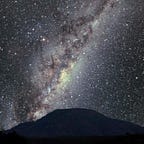Provide some real life examples, this might include videos, photographs or other creative mediums.
To me Pure Mathematics is the study of abstract theories such as “String Theory” — Aganagic. (2016), (See Figure 1 Pure Mathematics; String Theory Summarized — Joke.).
Whereas Numeracy or Applied Mathematics can be applied to a field of study or a real-world problem such as “Control Theory” — Schmitt, Harald, & Günther. (2004).
The Conscious Oxford Dictionary of Mathematics describes Pure Mathematics as “ The area of mathematics concerning the relationships between abstract systems and structures and the rules governing their behaviours, motivated by its intrinsic interest or elegance rather than its application to solving problems in the real world”.
I believe pure mathematics to be the explanation of systems currently beyond our physical or technological grasp. However it is important to note that there are strong possibilities of crossovers between Pure Mathematics and Applied Mathematics (See Figure 2. Example of Pure Maths Vs Applied Maths in the field of Science).
Figure 2. Example of Pure Maths Vs Applied Maths in the field of Science
It is my belief as an Indigenous educator that schools need to teach Nemeracy. An understanding of how skills can work within our world has been proven to be paramount particularly for Indigenous learners across all Key Learning Areas (KLA’s), (as shown in Figure 3 “8 Ways Learning Web” and 4 “8 Ways Learning Detailed Explanation”).
I know from my own personal background and my extensive work with Indigenous students that students must understand each part of the content extensively before they are able to put it together. I would therefore within my classroom alongside Pure Mathematics use activities such as:-
- Deconstructing real-world problems and reconstructing with synonyms
- Using pictorial graphs or symbolism within graphs to explain real-world data
- Inviting local elders groups into classrooms to work on activity based problems in small groups
- Teach young students numbers in cross cultural contexts by teaching students numbers 1 to 10 on Country and in Gomeroi language.
- Group discussions about when we have used math at home
It is my opinion that this allows for the engagement of students within classroom settings and creates harmonious working environments with an underlying importance centralised on developing mathematical skills and application competency.
To me these multi-sensory approaches give students ownership, practicality and understanding of content. Therefore, allowing them to comprehend the importance and usability of mathematics.
References
https://vickidrozdowski.files.wordpress.com/2012/10/individual-investigation-of-a-learning-theory-aboriginal-pedagogy.pdf
https://www.google.com.au/search?q=8+ways&rlz=1CALOFC_enAU776AU782&source=lnms&tbm=isch&sa=X&ved=0ahUKEwjM47GFiofdAhUYE4gKHfxuCjcQ_AUICigB&biw=1366&bih=654#imgrc=SxgPPLIQlGhjXM:
Mina Aganagic. (2016). String theory and math: Why this marriage may last. Mathematics and dualities of quantum physics. Bulletin of the American Mathematical Society, 53(1), 93–115.
Nahin, P. (2011). Dr. Euler’s Fabulous Formula. Princeton University Press.
New South Wales. Department of Education Communities. (2012). 8 ways : Aboriginal pedagogy from Western NSW.
Nicholson, J. (2014). Pure mathematics. The Concise Oxford Dictionary of Mathematics, The Concise Oxford Dictionary of Mathematics.
Romano, G., & Barretta, R. (2013). On Euler’s stretching formula in continuum mechanics. Acta Mechanica, 224(1), 211–230.
Schmitt, B., Schwalbe, Harald, & Wess, Günther. (2004). The Concept of “Buffering” in Systems and Control Theory: From Metaphor to Math. ChemBioChem, 5(10), 1384–1392.
